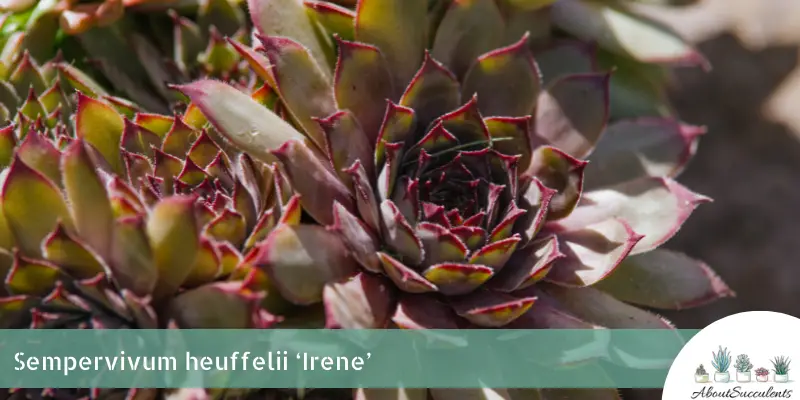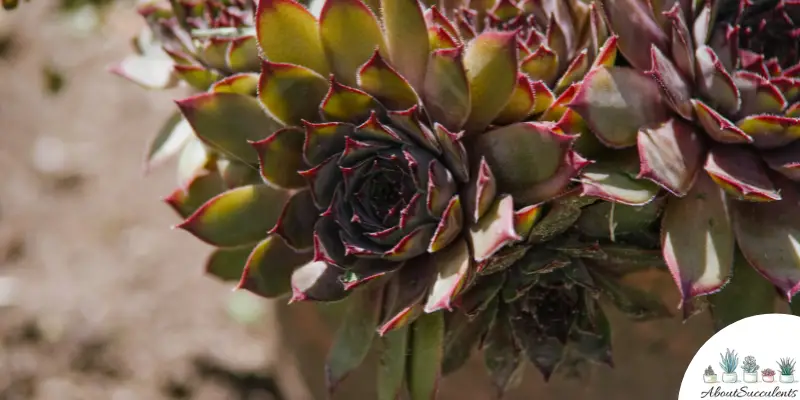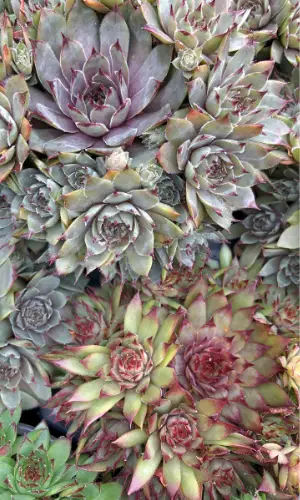
Sempervivum heuffelii “Irene” starts out as a tight and compact rosette with deep burgundy colored leaves that have hints of green on their edges. The “heart” or center of the rosette has a yellow-green color.
As winter approaches, the leaves turn from burgundy red to dark purple and the colors on the edges turn from green to white. The combination of colors, the symmetrical growth of the rosettes, and the lushness of its leaves make Irene a majestic addition to any outdoor garden or an indoor living room.
If your outdoor garden is frequently threatened by deer, place Irene beside your most precious plants and they’ll protect them from getting eaten.
Irene is an evergreen monocarpic that produces vegetative offsets through division. The offsets can be pulled out, dried out, and repotted for propagation or just left alone to grow into clusters of rosettes.
As a monocarpic, Irene will produce flowers after it matures or around 3 to 4 years. The yellow-colored flowers will come out in the late summer or early fall. Shortly after the flowers bloom, Irene will die.
Sempervivum heufelii Irene is native to the Balkans and Carpathians in Europe. It’s part of the genus Sempervivum and is a member of the Crassulaceae family. Fully-matured Irene can reach a height of 3-inches (7.5cm) tall with the rosettes growing up to 4-inches (10cm).
General Information
Also known as: Irene
Plant Family: Crassulaceae
Origin: Balkans and Carpathians in Europe
Height: 3-inches (7.5cm)
Exposure: Preferably sunlight for up to 6 hours every day but Irene will also do well under partial sunlight.
Water Needs: Drought-tolerant; use the “Soak and Dry” method for watering
Soil Type: Cactus mix or succulent soil with added 50% perlite, pumice, coarse sand, and lava rock to speed up soil drainage.
Soil pH: 6.6 to 7.5
How to Grow and Care for Sempervivum Heuffelii “Irene”

Sempervivum heuffeilii Irene is the ideal succulent to start with if you’re a first-time horticulturist. You don’t have to fuss over it. As long as you plant Irene in a location that guarantees its daily dose of the sun’s rays, you’ll be fine.
Irene is the perfect houseplant for those with a busy lifestyle because you don’t have to water it every day.
You might be on a flight for a 2-week vacation and suddenly forgot to water before leaving home. Don’t worry as Irene will be just fine.
Speaking of being a houseplant, this would be a good idea if temperatures in your region drop below -30° F (-34° C) because Irene doesn’t like the cold.
Sunlight
Sempervivum heuffelii Irene thrives when given regular sunlight. Not only will Irene produce food but the plant will achieve its maximum colors. It’s also not healthy if the succulent doesn’t get enough sunlight because its leaves will etiolate or stretch out, wither, and die.
If you want to plant Sempervivum heuffelii Irene in an outdoor succulent garden, find a location where it can get 6 hours of partial or full sunlight. It’s better for Irene to get full sun in order to bring out the magnificent dark purple colors and white-tinged edges of the leaves.
Just remember to avoid the early to mid-afternoon sun. During these hours, the sun rays are quite hot and these will burn the leaves of Sempervivum.
As an indoor plant, find a location where Irene can get 4 to 6 hours of partial sun. If it’s not possible to get sun exposure for that length of time indoors, buy a Grow Ligh for Irene and keep her under it for 6 hours per day.
Watering

Like other varieties of succulent plants, Sempervivum heufelii Irene stores water in its leaves and stems. This ability to store water allows them to survive harsh drought conditions.
Thus, if you forget to water Sempervivum, don’t worry. Irene will be okay. The problem starts when you give your succulent water too often.
If the soil is kept moist too long, it might become a breeding ground for bacteria and fungi. The roots of Irene will rupture and rot. This gives the bacteria the opening it needs to contaminate your entire plant.
Follow the “Soak and Dry” method for watering Irene. Check the soil level first by inserting a stick an inch deep into the topsoil. Pull out the stick and if it feels dry to the touch, then get ready to give the soil a good soaking.
You’ll probably water Irene every seven to 10 days during summer and spring and only once a month in winter.
Pot and Soil
A pot that’s made of unglazed ceramic or terracotta is best for Sempervivum heuffelii Irene because these types of pots help the soil free up excess moisture. Choose a pot that’s slightly larger than the base of the plant to give the roots enough space to grow.
Lastly, make sure the bottom of the pot has a drainage hole. When you see water leaking out of the drain hole, you can stop watering the soil.
Irene grows best when planted in sandy or gritty soil such as cactus mix or potting soil with added materials such as coarse sand, perlite, pumice, and lava rock. These materials will help speed up soil drainage.
How to Propagate Sempervivum Heuffelii “Irene”
Sempervivum heuffelii Irene made it easier for you to propagate the species by producing offsets or pups for you.
Offsets Method:
Step 1: Using a sterilized and sharpened knife, separate the clumps of offsets from the main plant. The roots must remain intact with the offsets.
Step 2: Allow the offsets to grow hard calluses over a period of 2 to 4 days.
Step 3: Once the calluses have formed, plant the offsets into well-draining soil.
Step 4: Water the soil lightly and place the pot in an area that gets up to 6 hours of partial sunlight daily.
Step 5: If the roots have taken hold properly, follow the “Soak and Dry” method for watering Irene.
Frequently Asked Questions
Is Sempervivum Heuffelii “Irene” Toxic to Cats and Dogs?
Sempervivum Heuffelii “Irene” doesn’t appear in the list of plants that are toxic to cats and dogs found on the website of the American Society for the Prevention of Cruelty to Animals (ASPCA).
Why Is My Sempervivum Heuffelii “Irene” Dying?
Sempervivum heuffelii Irene can survive a month without water but if you water it frequently, it can die from fungal infection caused by root rot.
Irene might also harbor pests that carry bacteria and diseases such as aphids and vine weevils. If you’re growing Irene indoors, make sure the plant gets enough air circulation. Otherwise, the leaves will develop gray molds.
Overwatering
If you notice the leaves of Irene looking and feeling mushy plus the appearance of yellow-blackish spots, these are signs of a fungal infection taking place inside the succulent.
You have to act right away and remove all of the infected sections with a sharpened and sterilized knife or garden shears. After each cut, sanitize the cutting tool with 70% isopropyl alcohol.
Next, repot the succulent. Remove the plant from the soil and cut off the infected roots. Let Irene rest and recover in a dry area while you fill out a new pot with fresh cactus or potting soil.
Don’t water Irene just yet. Give Sempervivum heuffelii Irene 2 to 3 days to get used to the soil before drenching it with water.
Pest Infestation
Aphids and vine weevils not only carry bacteria and fungi, but these pests will eat the leaves of Sempervivum. The best way to get rid of them is to use a diluted fungicide or insecticide. Neem oil is a natural product that’s popularly sprayed on succulents to get rid of pests.
Molds
If your indoor succulent doesn’t get enough air circulation in its area, molds can develop on Irene’s leaves. These molds can easily become infectious fungi that will harm your plant.
When you see molds growing on the leaves and other parts of the succulent plant, remove them right away and transfer Irene to a new location that gets plenty of air circulation.
Yes. Sempervivum heufelii “Irene” produces yellow-colored flowers after 3 to 4 years. As a monocarpic succulent, Irene will die after blooming flowers.
Last Updated on June 9, 2022 by Sofia Lara